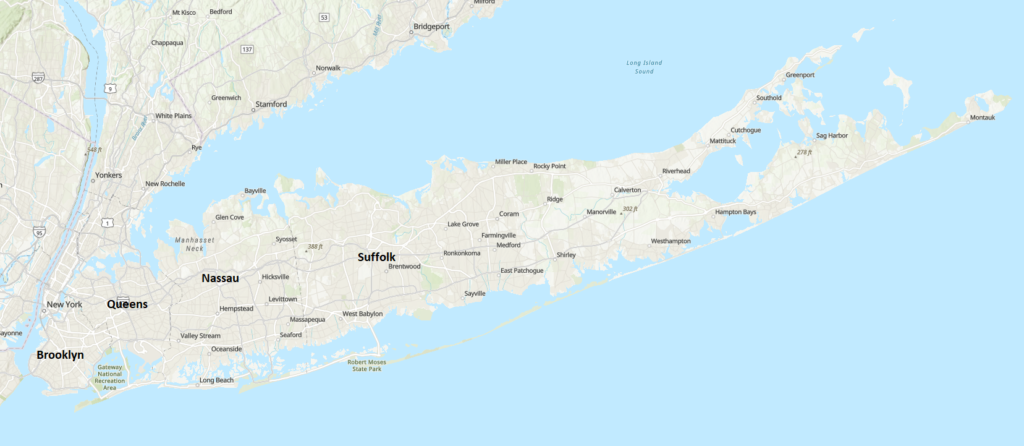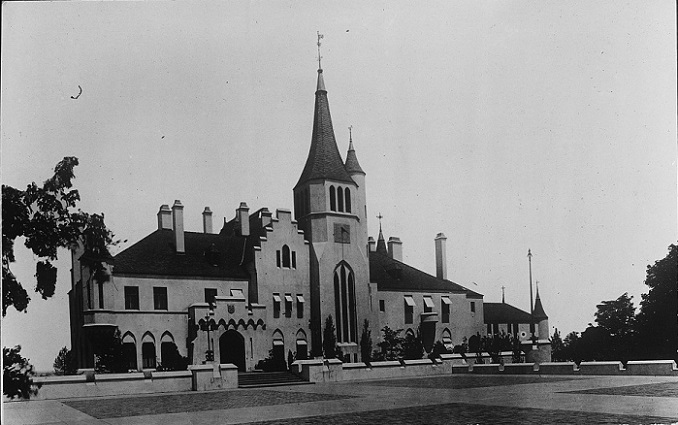Long Island
The focus of this project is Long Island which, as the name suggests, is an island located to the east of New York City. Geographically, the island is split into three main parts: Queens/Brooklyn, Nassau County, and Suffolk County. Working west to east, Queens/Brooklyn are two boroughs of New York City that are geographically located on the island. Nassau County lies directly to the east of these areas, and today is highly suburbanized. Lastly, Suffolk County encompasses the majority of Long Island’s geographic area, and parts of it, especially at the eastern end, are still rural. For the purposes of this project I will be using “Long Island” only to refer to Nassau and Suffolk counties, as Brooklyn/Queens are officially part of New York City, and culturally are considered to be distinct from Long Island.

For most of its existence, Long Island was predominantly farmland broken up by smaller towns. “Natural and societal forces, therefore, have made agriculture the basis for Long Island’s civilization” (Gabriel 34). Maritime industries such as fishing, oyster farming, and whaling also made-up significant parts of the economy in later years, but for the bulk of the island further inland, farming was the main way of life. And in many ways, the farmers shaped the island and prepared it for the later development it would experience. Writing in 1921, Ralph Henry Gabriel noted that:
Looking back over a span that covers nearly three centuries, it is possible to see a little more clearly the role that the farmer has played in the story of Long Island. It is not too much to say that into his hands was given the task of laying the foundation for the civilization of the region. He cleared away the forests and built and defended the first rough hamlets that dotted the shore. It was he who first laid out the roads that ultimately joined these settlements together. In the beginning, when practically all the people were farmers, it was on the fields and meadows that the life of the Island rested.
Gabirel 60-61
Even though the Island was far less developed in 1921 than it is today, Gabriel’s point still stands. Long Island was first and foremost a farming community, and farmers set the stage for everything that would come next. The vast swaths of undeveloped land allowed wealthy residents of New York City to easily purchase and develop them into estates; a process that would later occur in droves.
Another important feature of early Long Island history is its isolation. Access to the rest of the country requires crossing several rivers and going through New York City; a complicated trip even today and one that was more arduous when transportation was slower. Because of this, Long Islanders were fairly separate from the city that was next door; at least until transportation was built to connect them.
Today, Long Island connects to New York City via bridges, highways, and the Long Island Rail Road (LIRR). The LIRR is a mostly commuter line that is currently used to provide transit for Long Islanders who make their living in the city. The development of the railroad in the mid-nineteenth century partly contributed to Long Island’s development and allowed the residents of New York City to easily access the island. The LIRR opened in 1844 and brought development to different areas of the Long Island as more branches were added (Gabriel 135, 176). It also brought an end to its isolation, since “until 1844, New York City had been three days away from [eastern Long Island]. It was now five hours” (Gabriel 136).
By the late nineteenth century access was easy and convenient, and Long Island began a new chapter as a recreational area for city residents. Gabriel noted as much when he stated that “lying at the doors of the American metropolis, the Island has become the playground of New York” (Gabriel 166). Recreational trips were a pastime for people of all social classes; for example, Coney Island and other South Shore beaches became a favorite escape for city residents (Gabriel 180). For the wealthy, however, the draw to Long Island was more than a desire to take a day trip to a beach crowded with city dwellers.
Gold Coast Estates
Gold Coast estates are sometimes classified by different terms, with distinctions between each one. Estate, farm, country home, mansion; it is hard to define what would qualify as each. Because of this, I will be using the terms interchangeably, with the default being “estate.”
As Long Island accessibility increased, the expansive amounts of land and proximity to New York City attracted upper-class members of society to begin buying land and building. Beginning around 1890 and continuing until the Great Depression in roughly 1930, this period is notable for its opulence, extravagance, and feeding the whims of the mega-wealthy. A “Gold Coast Estate” then, is one built during this period by a member of the upper crust of society, for the purpose of impressing, entertaining, and displaying their wealth.
“Gold Coast” is a common and widely accepted descriptor for the north shore of Long Island and is generally considered to encompass the northern part of Nassau County, and the northwestern part of Suffolk County. However, I could not find any information on how this boundary was created or who first coined the term “Gold Coast.” Because of this, it is hard to say if the geographic bounds of the Gold Coast were consciously known and adhered to by the wealthy of this time, or if it was later historians who decided what constituted a Gold Coast mansion, as well as what was excluded.
For many of these mega-wealthy estate owners, however, their Long Island home was not their primary residence.
Virtually all of the estates, with few exceptions, were intended to be secondary country homes. Since in the late 1800s and early 1900s Long Island was considered unhealthy in the summer due to mosquitoes, summers were spent in such places as Newport, the Adirondacks, or Maine, while spring and autumn were spent on Long Island. In the winter, households returned to Manhattan and Brooklyn, or went to the Carolinas, or to Palm Springs .
Spinzia vii
For the ultra-rich, their Gold Coast estate might be just one of many homes they had, whereas for other less wealthy people, it might be a primary residence. This of course begs the question, why did people spend so much time and money building an estate they might not even live in most of the year?
The simple answer to this is that an estate was a physical manifestation of wealth and power; a way to show off to friends, neighbors, and competitors. The larger and grander a house one built, the more wealth and power they seemingly held. An excellent example of this is in Otto Kahn, an investment banker and German immigrant who build his country home “Oheka” from roughly 1915-1917. When construction finished, Oheka was a 72 room mansion with 25 bathrooms; much larger than the Kahn’s town house in New York City, which only had 62 rooms (Mackay 13). In fact, Oheka, remains to this day the second largest house in the United States, with the Vanderbilt’s famous Biltmore mansion being the largest (Spinzia 426). But the extravagance of Oheka didn’t stop at its size. Kahn was a bit late to the game in building his mega mansion and missed on out the prime spots (Mackay 29). To compensate, he had trainloads of dirt brought in to create an artificial hill on which to build his house; perhaps in order to give his estate a literally looming presence over those of his peers (Spinzia xi).
Being an immigrant, Kahn was also part of the “new money” class – those who were self-made rather than coming from generational wealth. The tensions between old and new money were certainly present during this time, begging the question of how apparent they might be in house construction. Kahn wasn’t the wealthiest person to build an estate on the Gold Coast, so what was he trying to prove by making his seasonal home so extravagant?
The Gold Coast Era was at its core one of opulence and extreme shows of wealth and power. Yet even though the age of the estate has long since faded, it still retains a hold in our cultural memory. This might be best exemplified in The Great Gatsby, F. Scott Fitzgerald’s 1925 novel that brought this lifestyle into the hands and classrooms of people across the country. The book explores the tensions between old and new wealth, the extravagance of the mega-wealthy, and lifestyles of those who lived it. Fitzgerald supposedly based the houses of West and East Egg on several very real Gold Coast estates; most notably Beacon Towers. Unfortunately, this house was torn down in 1943 to make way for a housing development (Randall 10-11; Spinzia 55). Yet even if the inspiration point is long since gone, the idea of the Gold Coast Era and lifestyle is one we continue to hold on to.
After the Gold Coast
Following the stock market crash of 1929 and World War II, the allure and grandeur of Gold Coast estates began to wane. Part of this was due to the financial situations of people; as families grew bigger, their wealth became more dispersed among heirs, leaving individuals less wealthy than their ancestors (Spinzia x). But it also had to do with the economy and changing times at large. Rising property taxes played a large role, with many estate owners incorporating their land as villages or demolishing parts of their houses to keep the taxes lower (Spinzia viii). Yet another reason was the decreased need for estates and country homes. As times changed people cared less about the extravagance these houses once represented, and without the care or money to keep up with maintenance, the homes fell into disrepair (Mateyunas 9).
Also compounding the change was an increase in development on Long Island after World War II. Many houses were demolished in the 1950s, and properties were broken up to create housing developments to match the growing population (Mateyunas 9). Additionally, the construction of the Northern State Parkway and Long Island Expressway led to the loss of estate acreage, as the Long Island Expressway in particular cut through several properties (Mateyunas 9).
Yet despite all of this, there are many estates that are still standing today. Some survive in new forms, such as museums, state parks, religious centers, and educational buildings, but others remain private residences. And of course, they live on in our cultural memory.
Next page: Methodology

